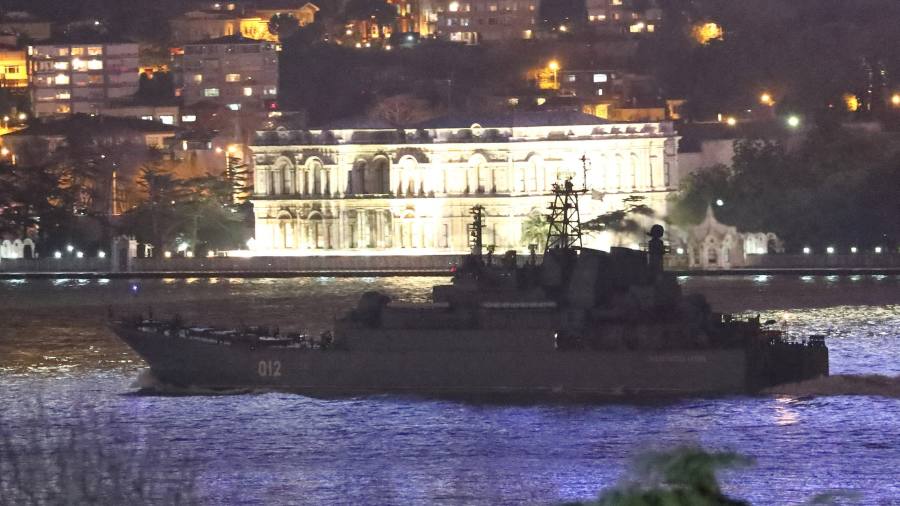Receive free War in Ukraine updates
We’ll send you a myFT Daily Digest email rounding up the latest War in Ukraine news every morning.
Ukraine attacked the oil export infrastructure that helps fund Moscow’s invasion for the first time on Friday, using a drone strike to damage a Russian naval vessel outside the port of Novorossiysk.
Ukraine’s security services, in collaboration with the country’s navy, carried out the sea drone strikes outside the port, according to two Ukrainian sources with knowledge of the operation. Novorossiysk is a major navy base and oil-exporting port located east of Crimea, which Russia annexed in 2014.
Videos posted on social media, which could not be verified, showed a naval vessel tilted to its side being towed by tug boats back to port. Separate videos released by Ukraine’s armed forces showed footage from a camera mounted on a sea drone as it approached a vessel at night.
“As a result of a drone attack in Novorossiysk Bay, the large amphibious ship Olenegorsky Gornyak was damaged,” said Serhiy Bratchuk, a spokesperson for military administration in the Ukrainian port of Odesa, in a social media post.
The attack follows a series of Russian strikes on Ukraine’s grain export infrastructure in recent weeks, raising the spectre of escalating reprisals as the countries target each other’s main sources of export income.
Moscow moved to reimpose its full naval blockade of Ukrainian ports this summer after it withdrew from a UN-brokered grain export agreement that allowed shipments despite the war.
While the US has broadly tolerated Ukrainian strikes on Russian soil, as long as they do not utilise western-supplied weapons, the attack on oil export infrastructure is likely to cause concern in the White House and other western capitals.
The US has led the push to keep Russian oil in the market to stop global prices from rising and damaging the world economy, with President Joe Biden’s administration wanting pump prices to remain stable ahead of next year’s presidential election.
Novorossiysk is Russia’s main Black Sea oil port, exporting about 600,000 barrels a day. It is also the main export point for oil from Kazakhstan, with the 1.2mn b/d line from the Caspian Pipeline Consortium terminating there.
The CPC, in which US oil major Chevron holds a stake, said a “temporary ban” on ship movements had been introduced at the port, but that tankers at berth continued to load. It added there was “no damage” to the pipeline’s infrastructure.
Russia claimed their forces had repelled Friday’s attack. “Tonight, the armed forces of Ukraine attempted to attack the Novorossiysk naval base with two unmanned boats,” Russia’s defence ministry said in a statement.
“In the course of repulsing the attack, unmanned boats were visually detected and destroyed by fire from the standard weapons of Russian ships guarding the outer ring of the naval base,” the statement added.
Andrei Kravchenko, the mayor of Novorossiysk, said in a statement that “the crews of the Olenegorsky Gornyak and Suvorovets ships reacted instantaneously and helped avert the consequences of an attack by drone boats”.
There were no casualties or destruction as a result of the attacks, Russia’s Interfax news agency reported, citing the governor of the wider region.
Oil prices have risen almost 15 per cent in the past month to nearly $85 a barrel, but the market reaction to the attack was relatively muted on Friday, with Brent crude edging up 0.5 per cent to $85.50 a barrel.
Ukraine has — without directly claiming credit — conducted sea and aerial strikes on military targets in or near Crimea as well as on Russian soil since President Vladimir Putin launched his full-scale invasion last year.
Ukraine previously used surface-to-sea missiles to sink the Moskva, the flagship cruiser of Russia’s Black Sea Fleet, last year off the Crimean coast. Moscow has also been hit by a series of drone attacks in the past week, including two that struck its central business district.
Russia’s defence ministry said on Friday that Ukraine had, in addition, conducted aerial drone attacks in Crimea, but there had been no casualties. Ten drones were destroyed by air defences and three more had been “suppressed by electronic warfare”, it added.
Read the full article here



